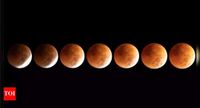On the night of September 7, 2025, the world looked up in awe as the Moon underwent a breathtaking transformation, turning a deep, fiery red in a phenomenon known as the “blood moon.” For millions across Africa, Europe, Asia, and Australia, the spectacle was not just a rare astronomical event—it was a shared moment of wonder, captured in countless photographs and memories. From bustling city rooftops to tranquil rural landscapes, people gathered to witness the total lunar eclipse, marveling at the Moon’s dramatic shift from its usual silvery glow to a haunting crimson hue.
According to NASA, this celestial display occurs when the Earth lines up directly between the Sun and the Moon, blocking the Sun’s rays from hitting the lunar surface. Instead of plunging the Moon into complete darkness, Earth’s atmosphere bends and scatters sunlight, filtering out the shorter blue wavelengths and allowing only the longer red and orange wavelengths to reach the Moon. This process, which also colors our sunsets, bathes the lunar surface in a reddish-orange glow—a sight that has captivated humanity for millennia.
As reported by ABC News, optimal viewing conditions for the September 2025 blood moon were found in Africa, Europe, Asia, and Australia. The United States, which had enjoyed a spectacular blood moon earlier that March, missed out this time, but that didn’t dampen global enthusiasm. Social media buzzed with excitement as skywatchers shared their experiences and stunning photographs. The event’s totality lasted about 82 minutes, making it the longest total lunar eclipse since 2022, according to Live Science.
Photographers around the globe seized the opportunity to document the Moon’s eerie transformation. In China, the blood moon rose majestically above the Olympic Park Observation Tower in Beijing and the cityscape of Jiujiang. In Germany, the Moon’s crimson disc appeared behind the spires of Berlin’s Oberbaumbruecke bridge, while in the Netherlands, it hovered over residential buildings in Eindhoven. From the air traffic control tower at Athens Airport in Greece to the bustling promenades of Beirut, Lebanon, and the star-topped skyscrapers of Moscow, Russia, the blood moon provided a dramatic backdrop to familiar landmarks, uniting people in a moment of shared celestial wonder (CNN, Live Science).
In Leipzig, Germany, onlookers watched from park benches as the Moon slowly shifted in color. In New Delhi, India, the blood moon was seen above a mosque, and in Cairo, Egypt, it appeared near the beginning of the eclipse, glowing above the city’s skyline. Even in partial phases, as seen in Najaf, Iraq, the lunar eclipse drew crowds eager to catch a glimpse of the extraordinary event. As the Moon passed through Earth’s darkest shadow, known as the umbra, it was completely enveloped for more than an hour, an occurrence that only happens when the Moon, Earth, and Sun are perfectly aligned.
The science behind the blood moon is as fascinating as its appearance. Unlike solar eclipses, which require special eye protection and are visible only along narrow paths, lunar eclipses can be safely observed with the naked eye and are visible across vast regions of the globe. As Forbes explains, the Moon remains visible during the eclipse because some sunlight refracts through Earth’s atmosphere and continues on to illuminate the lunar surface. The dramatic red color is the result of the same atmospheric scattering that gives rise to vivid sunsets and sunrises, making the spectacle both a scientific and aesthetic marvel.
For those who missed the September 2025 event—or simply want to experience it again—the good news is that more blood moons are on the horizon. According to NASA and multiple sources, the next total lunar eclipse will occur on March 2-3, 2026. This event is set to be visible across the Americas, the Pacific Islands, Asia, and Australia. Skywatchers in the western United States and Canada will enjoy the Moon high in the sky during totality, while those in eastern North America may catch only the tail end before moonset. The totality is expected to last approximately 58 minutes, offering another chance to witness the Moon’s fiery transformation.
Looking further ahead, the lunar eclipse calendar is dotted with notable events. On December 31, 2028, into January 1, 2029, a total lunar eclipse will coincide with New Year’s Eve celebrations, providing a stunning celestial backdrop for revelers in Europe, Africa, South America, and the eastern United States. This eclipse will feature over 71 minutes of totality, with the Moon glowing a deep blood-red as fireworks light up the skies below. June 26, 2029, will bring a 102-minute eclipse visible from the Americas, Europe, Africa, and the Middle East, and another 54-minute eclipse will occur on December 20, 2029, spanning the Americas, Europe, Africa, and Asia.
For those eager to catch the next blood moon, experts recommend a few simple tips to enhance the experience. First, choose a viewing spot far from city lights, where the sky is darkest and the Moon’s colors are most vivid. Binoculars or telescopes can help reveal more detail on the lunar surface, but they aren’t necessary to appreciate the event’s beauty. Dress warmly, especially for late-night or early-morning viewings, and bring a comfortable chair to settle in for the show. Most importantly, consult local eclipse timing guides, as the duration and visibility of totality can vary significantly depending on your location and weather conditions (Forbes, Live Science).
Lunar eclipses have long inspired myths, legends, and scientific inquiry. Ancient cultures saw them as omens or messages from the gods, while today’s astronomers use them to study the Moon’s surface and Earth’s atmosphere. Yet, regardless of our scientific understanding, the blood moon continues to evoke a sense of awe and unity. As millions paused to watch the September 2025 eclipse, they were reminded of the beauty and mystery of our universe—a reminder that, sometimes, all it takes is a glance upward to feel connected to something much larger than ourselves.






